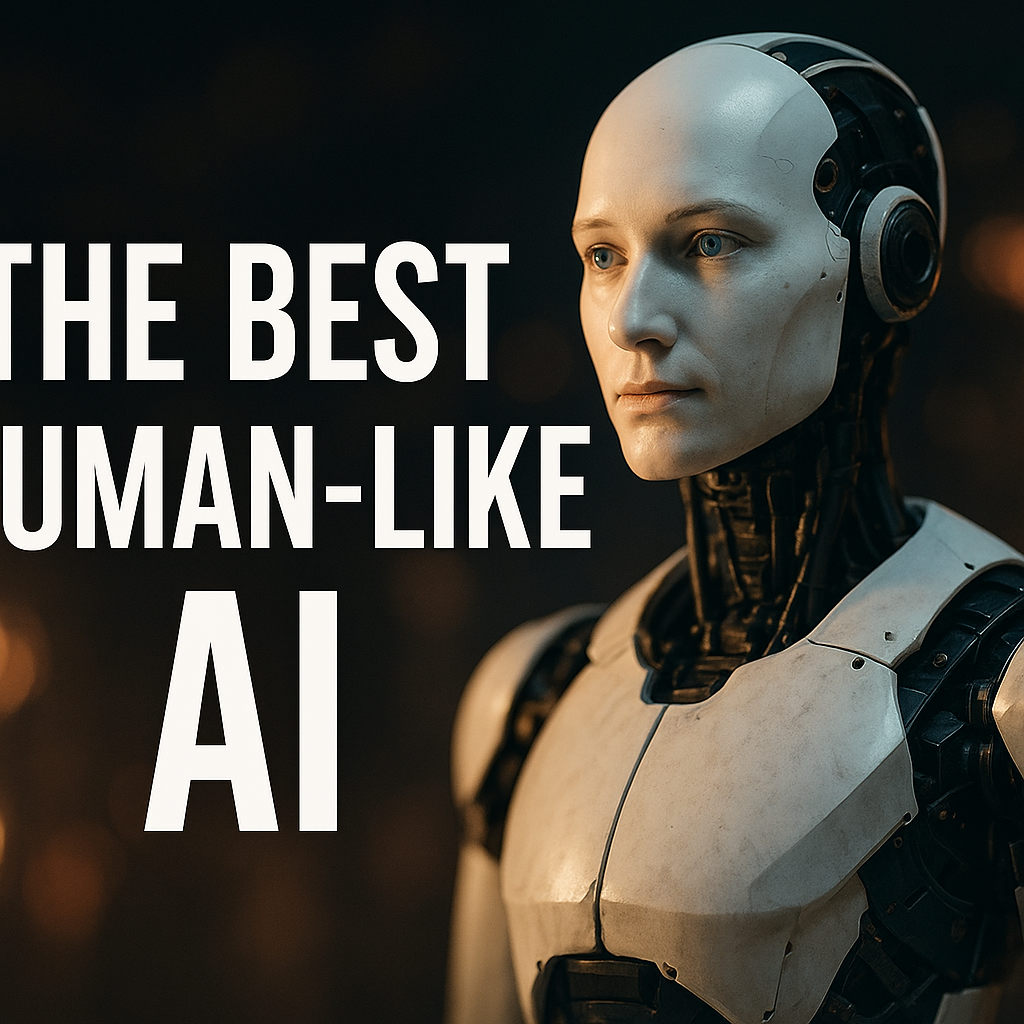Introduction
Artificial Intelligence (AI) has been evolving at a breakneck pace. From basic algorithms to complex neural networks that can mimic human conversation, creativity, emotions, and even ethical reasoning — the journey has been both fascinating and a bit unsettling. In 2025, we are seeing AI technologies that are nearly indistinguishable from human interaction in many ways. This article dives deep into the best human-like AI systems, how they function, their real-world applications, ethical implications, and what the future holds.
Section 1: Understanding Human-like AI
What is Human-like AI?
Human-like AI refers to artificial intelligence systems designed to replicate human reasoning, communication, creativity, and emotion. These systems don’t just compute—they simulate aspects of the human brain through Natural Language Processing (NLP), Emotional AI (Affective Computing), Generative AI (text, image, video), and Deep Learning.
Key Characteristics
- Natural Conversation Skills
- Emotional Recognition and Response
- Contextual Understanding
- Decision-making and Ethical Reasoning
- Creative Abilities (Art, Music, Writing)
Section 2: Top Human-like AI Systems in 2025
Here are the most advanced and human-like AI technologies today, used in both consumer and enterprise environments.
1. OpenAI’s ChatGPT-4o
- Technology Used: Transformer-based LLM with multimodal capabilities
- Strengths: Emotionally intelligent conversations, code writing, visual input, memory
- Applications: Education, Business Automation, Customer Service, Therapy, Content Creation
ChatGPT-4o (short for “omni”) is the most conversational and empathetic version of OpenAI’s chatbot family. With its multimodal input (text, vision, voice), it can carry a human-like dialogue, understand emotions, and even suggest therapy-like responses. Its writing style often feels like you’re speaking to a knowledgeable friend.
2. Google Gemini 1.5 Pro
- Technology Used: Large Language Model integrated with Google ecosystem
- Strengths: Seamless integration with Gmail, Docs, YouTube; contextual memory
- Applications: Business Intelligence, Writing Assistance, Research, Data Analysis
Gemini is not just a chatbot but a productivity enhancer. It mimics human workflow — helping users summarize emails, generate reports, analyze trends, and even create content from voice memos or spreadsheets.
3. Anthropic’s Claude 3.5
- Technology Used: Constitutional AI
- Strengths: Ethical reasoning, clarity, balanced responses
- Applications: Legal Tech, Healthcare Advising, Educational Tools
Claude 3.5 focuses on being aligned with human values through a unique training approach. It answers questions based on a “constitution” of ethical guidelines. This makes it ideal for sensitive applications like law, medicine, and education.
4. Meta AI’s LLaMA 3 and Code LLaMA
- Technology Used: Open-source LLMs for developers
- Strengths: Human-like reasoning in open environments
- Applications: Development, Education, Code Generation, Open-source Innovation
Meta is driving open innovation with its LLaMA 3 model family. While not as chat-polished as ChatGPT or Gemini, its code models can teach and learn interactively, helping developers build new apps in a more human-interpretable way.
5. xAI’s Grok (Elon Musk-backed)
- Technology Used: Real-time AI trained on X (formerly Twitter) data
- Strengths: Culturally aware, witty, casual tone
- Applications: Social Media Automation, Trend Analysis, Real-time Communication
Grok is a culture-focused AI that understands memes, slang, and social dynamics. Though not the most formal, it’s among the most “internet-native” human-like AIs, reflecting online human behavior patterns.
Section 3: How Human-like AI is Changing Lives
1. Education & Tutoring
AI tutors like ChatGPT and Claude are helping students across India, the US, and Europe understand complex topics in their native languages with personalized teaching styles.
2. Healthcare & Emotional Support
AI therapists are not replacing real therapists but augmenting mental health services. Tools like Woebot and ChatGPT can help people manage anxiety, journal thoughts, and even practice mindfulness.
3. Creative Professions
From music generation (like Suno AI) to AI filmmaking (like Sora by OpenAI), creators now collaborate with AI to generate screenplays, animations, artwork, and even lyrics — opening up new artistic frontiers.
4. Customer Service
Human-like AI has improved customer support across banks, airlines, eCommerce platforms, offering 24×7, multilingual, emotionally sensitive assistance.
Section 4: The Challenges and Ethical Debates
While the rise of human-like AI offers promise, there are critical issues that governments, companies, and individuals must confront.
1. Misinformation & Deepfakes
AI that sounds and looks human can be abused to spread fake news, scam calls, or impersonate others.
2. Emotional Manipulation
AI that understands human psychology could influence buying decisions, political opinions, or even emotions—raising ethical questions about transparency and consent.
3. Privacy Concerns
AI learns from our data. If not carefully regulated, companies can misuse private chats, health data, or preferences.
4. Bias and Discrimination
Human-like AI can reflect human prejudices if trained on biased data. Constant monitoring and bias audits are essential.
Section 5: Regulations Around Human-like AI
Governments and international bodies are stepping up to regulate human-level AI.
- EU AI Act (2025): Focuses on transparency, labeling, and safety
- India’s Digital India AI Ethics Framework: Promotes responsible AI development
- US AI Safety Summit (2024): Collaboration between tech giants and regulators
Section 6: Future Possibilities with Human-like AI
Looking ahead, AI might soon:
- Act as personal life coaches
- Be embedded in robots that help the elderly
- Assist doctors in surgery and diagnosis
- Create entire businesses autonomously
- Write movies, books, and music independently
The line between human creativity and AI innovation will blur even more in the coming years.
Conclusion
AI systems in 2025 are no longer just tools—they are collaborators, companions, and in some cases, counselors. The best human-like AIs not only understand our language but also emotions, context, culture, and creativity. While this presents amazing opportunities for businesses, students, artists, and professionals, it also demands ethical responsibility and transparent governance.
AI is not here to replace us but to amplify human potential—as long as we remain thoughtful in how we build and use it.
